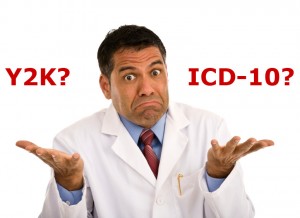 Like many IT professionals, I lived through the onslaught of the Y2K “millennium bug”. My current life during the push for ICD-10 compliance in healthcare makes it feel like deja vous all over again. You may ask, what do ICD-10 and Y2K have in common? Good question. Just like during Y2K, we IT professionals are spending many hours analyzing databases. This time we are looking for all of those places that ICD-9 codes are hiding and determining the impact that changing those databases will have on existing applications and reports. Business analysts need to dig into business processes and determine key changes brought about by the ICD-10 codes, which include more extensive physician and nursing documentation. Simply put, the most glaring consistency between ICD-10 and Y2K is that the “fix” is not as simple as it appears. In Y2K we couldn’t merely shove a “19” in front of the stored year. With ICD-10 we cannot simply chase down general equivalency mapping of ICD-9 to ICD-10.
Like many IT professionals, I lived through the onslaught of the Y2K “millennium bug”. My current life during the push for ICD-10 compliance in healthcare makes it feel like deja vous all over again. You may ask, what do ICD-10 and Y2K have in common? Good question. Just like during Y2K, we IT professionals are spending many hours analyzing databases. This time we are looking for all of those places that ICD-9 codes are hiding and determining the impact that changing those databases will have on existing applications and reports. Business analysts need to dig into business processes and determine key changes brought about by the ICD-10 codes, which include more extensive physician and nursing documentation. Simply put, the most glaring consistency between ICD-10 and Y2K is that the “fix” is not as simple as it appears. In Y2K we couldn’t merely shove a “19” in front of the stored year. With ICD-10 we cannot simply chase down general equivalency mapping of ICD-9 to ICD-10.
What ICD-10 and Y2K have in common is twofold:
- Both are a lot of hard work
- Both provide an opportunity to examine and improve existing business processes
Fortunately, unlike Y2K, ICD-10 will not be viewed in retrospective as a “non-event.” At this point, most organizations should be out of the planning stage and well into the ICD-10 remediation effort to meet the October 2013 deadline. The ICD-10 effort will have to be methodical, orderly and carefully executed. This careful planning carries the potential to improve the quality of operations and the level of understanding in a complex healthcare business. Also, unlike Y2K, which felt unrewarding, ICD-10 remediation can save time, money and maximize return in the long run for the U.S. healthcare delivery system.
Given the increased level of diagnostic detail afforded by ICD-10, this remediation effort is a good time to consider re-structuring how a healthcare organization views its service lines for operations and profitability. The reward for the pain found in analysis, database remediation, database migration and testing is a new detailed capability to examine the profitability and costs by procedure, the costs of specific diagnoses, and potential specific operational savings from best practices. ICD-10 will introduce a new level of transactional analysis by virtue of the expansion of the sheer number of new codes from ICD-9.
When faced with re-working all of the existing analytic reports built around ICD-9 codes, an organization can examine the bigger picture of how their business intelligence, decision support and analytics should perform. The remediation of the databases for ICD-10 will lead to new opportunities for building more comprehensive data marts and stronger operational reporting including digital operations dashboards. For the more progressive IT teams, ICD-10 remediation could be an opportunity to move to more of a self-service model for reporting that capitalizes on the new generation of business intelligence tools.
My best advice to healthcare organizations watching the ICD-10 time clock: Don’t treat ICD-10 as just another compliance issue. Instead, use this as an opportunity to examine and improve your healthcare business. Your bottom line will thank you.
